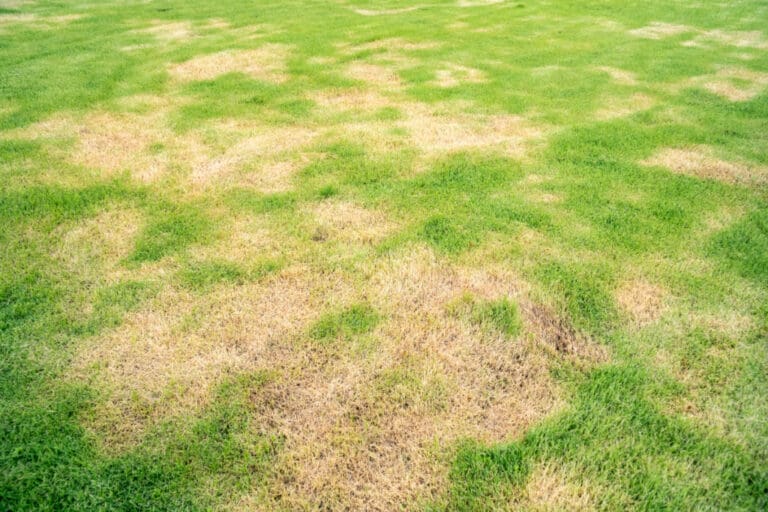The climate in Pennsylvania is ever-changing, and it’s not stopping anytime soon. Just like all living things, grass will need to learn to adapt, or they will simply wither away. Any living thing that possesses the capability to move around will always have a higher chance of survival, which means that your grass gets the short end of the stick here. Changes such as flooding and wetter winters are happening, and they are altering habitats as a result. We’ll go over common types of grass in Pennsylvania, and what you can do to maintain their shine.
You Will Read
What Are The Most Common Types Of Grass In Pennsylvania?
The most common type of grass in Pennsylvania are:
1. Kentucky Bluegrass
Kentucky Bluegrass makes for the perfect lawn for most lawn owners. When this grass is being taken care of properly, it can have your lawn looking dense and lush. Kentucky Bluegrass has a soft velvety texture, a dark-green color, and a canoe-shaped leaf tip. It also has a high tolerance to heavy traffic, which makes this grass pretty durable.
How to grow Kentucky Bluegrass:
If you desire the best results, we recommend growing Kentucky Bluegrass in the fall, however, there is still potential to grow it successfully during the springtime.
If you want to know how to grow Kentucky Bluegrass, you’ll need to first aerate your lawn by creating small holes in the soil. Then, seed and overseed. You can use a broadcast spreader or slice seeder to do this. Most importantly, you must follow up with some fertilizer. By booking your local Pennsylvania lawn care service, you’ll know exactly what your lawn needs to grow happy and healthy grass.
2. Perennial Ryegrass
Perennial Ryegrass is characterized as cool-season, fine-bladed lawn grass. It is used for both permanent and temporary lawns and is a beautiful bright green color. Similar to Kentucky Bluegrass, it grows best during fall and springtime. It also has a fast germination rate, which means that your seeds will sprout much more rapidly.
How to grow Perennial Ryegrass:
Perennial Ryegrass is a turf-grass type that requires a decent amount of moisture. It will need just the right balance of fertilizer and irrigation, otherwise, it will go dormant in the summer months. Once the grass begins to sprout, make sure your grass stays maintained at a height of one and a half to three inches. When this grass sits taller, it is less likely to form clumps. By following these steps, your lawn will look uniform and cohesive!
3. Rough Bluegrass
Rough Bluegrass is a fine-bladed yellow-green grass. The leaf blades slightly taper to form a boat-shaped tip. The lower surface of the blade is glossy, and the upper surface has a characteristic median midrib. This grass can also have a reddish hue and can appear patchy.
This grass has an intolerance to heat, traffic, and drought. Sometimes, it can be used along with Perennial Ryegrass for overseeding of golf courses during the winter. Some people tend to confuse this type of grass with Kentucky Bluegrass. When you need to tell them apart, look for the above-ground stems of Rough Bluegrass, whereas Kentucky Bluegrass has below-ground stems.
How to control Rough Bluegrass:
The only time Rough Bluegrass can be beneficial is when it is used on a golf green as a turfgrass in winter. Otherwise, it is considered a weed that we want nothing to do with. It often spreads aggressively and takes over the grass that is already on your lawn. When it dies during the summer, your lawn can be left looking patchy with bare spots.
To kill this weed, you have to deprive it of moisture, which means you have to stop watering. We recommend cutting the grass no shorter than three to four inches and fertilizing the lawn regularly. Most lawn care professionals recommend four feedings per year.
4. Fine Fescue
Fine Fescue is known for its shade tolerance and thin blades. This grass will remain green year-round in many areas and doesn’t need a lot of moisture or fertilizer to survive. It has many species, such as Hard Fescue, Sheep Fescue, Chewings Fescue, Creeping Red Fescue, and Slender Creeping Red Fescue. Many of these species form clumps, and their leaves are medium green to blue-green with a fine texture, as identified by Gardening Know How.
How to grow Fine Fescue:
Because the blades are so thin, they are unable to withstand the summer heat. If your lawn is in a cool area with an abundance of shade, this grass will benefit when grown there. Though it has a low need for irrigation, it will need consistent watering when attempting to grow. If you’re looking to grow Fine Fescue in areas with heavy traffic, it is less likely to survive. They are likely to have a better chance of survival when grown at home. Growing this grass will require a soil pH of 5.0 to 6.5.
5. Tall Fescue
Tall Fescue is a cool-season grass with improved heat tolerance, resistance of disease, a bunch-forming growth habit, and a tolerance of cold, heat, drought, and shade. This grass provides lawn owners with the opportunity to improve the resilience and durability of the lawn as well. It is extremely versatile and suitable for Northern regions.
How to grow Tall Fescue:
To grow Tall Fescue, it’s crucial to know the best timing. This grass sprouts best with a soil temperature of anywhere from 60 to 65 degrees Fahrenheit. During the fall, you’ll want to wait until the soil cools to this preferred temperature. During the spring, hold off until the soil warms. Following these guidelines will ensure optimal growth, and you won’t need to water quite as much, thanks to the fall and spring precipitation.
6. Zoysia Grass
Zoysia Grass is tolerant to drought and can accommodate a mild amount of traffic. When it reaches its mature state, the blades will appear bright to medium green. If you compare it to other warm-season grasses, it is very low maintenance. However, it does come with some disadvantages.
Unfortunately, it is difficult to keep this grass green year-round. It looks great for a few months out of the year, but will eventually become less saturated as fall approaches. To maintain green grass on a regular basis, it’s best to consult your local lawn care company in Pennsylvania for recommendations and expertise.
How to grow Zoysia Grass:
As Zoysia Grass begins to lose its color closer to fall, we recommend planting this grass from late spring to early summer for best results. Zoysia tends to develop a straw-like texture during the winter months and turn brown. To flourish, it will need direct sunlight. If given too much shade, it has the potential to invite weeds to grow in its space. Even though it can tolerate little moisture, it will grow best on an inch of water per week.
What Is The Best Grass To Grow In Pennsylvania?
The best grass to grow in Pennsylvania is Kentucky Bluegrass. It is extremely adaptable, makes for an ideal lawn texture, and can still survive in the winter, despite its need for full sunlight. This grass also emerges with a stunning deep-emerald-green color, which makes for a lawn that everyone is eager to show off.Kentucky Bluegrass vs Tall Fescue
Both varieties are similar in that they are both cool-season grasses, have a better ability to cope well in various climates, and are more commercially available. But what sets them apart?Tall Fescue:
- More traffic-resistant.
- Low maintenance with a need of about an inch of water on a weekly basis.
- Has the ability to fight off weeds and diseases in the summertime.
- Needs at least four hours of direct sunlight to survive.
Kentucky Bluegrass:
- Less traffic-resistant.
- More high maintenance, as it needs closer to two inches of water per week.
- More vulnerable to weeds and diseases during hot summer months.
- Needs at least eight hours of direct sunlight to survive.
Protecting Your Lawn with Go Green Lawn and Pest Control
With a combination of industry expertise and knowledge of the local environment, we aim to create a custom approach to solving your needs with our lawn care services in Pennsylvania. We strive to preserve our community through Trusted treatments so that you can benefit from a healthy lawn. We’ll know exactly what your lawn needs, and when it needs it—conducting a thorough analysis and inspection on each visit. If you’re ready to Go Green, call us at 610-285-7947 and get your free lawn care quote today!
How Do I Know if I Have Moles in My Backyard?
As a homeowner, you are responsible for keeping your yard and plant life safe from pests and wildlife. There is a wide range of animals and insects that can cause damage to your landscaping, including unlikely ones like moles. But how do you know if you have moles digging around

Lawn Care Tips for the Winter Months
Want to help your yard and garden thrive throughout the coldest part of the year? There are plenty of steps homeowners can take to help keep their plants healthy during the winter and ensure they are in good shape by springtime. Here are four lawn care tips for winter seasons

4 Tips For Pest Control in the Winter
During winter, as the weather gets colder, pests tend to seek refuge and look for places to live inside your home. But most people are oblivious to this and that winter pest control is a paramount undertaking. The notion that these vermin get dormant during cold weather is not true.












